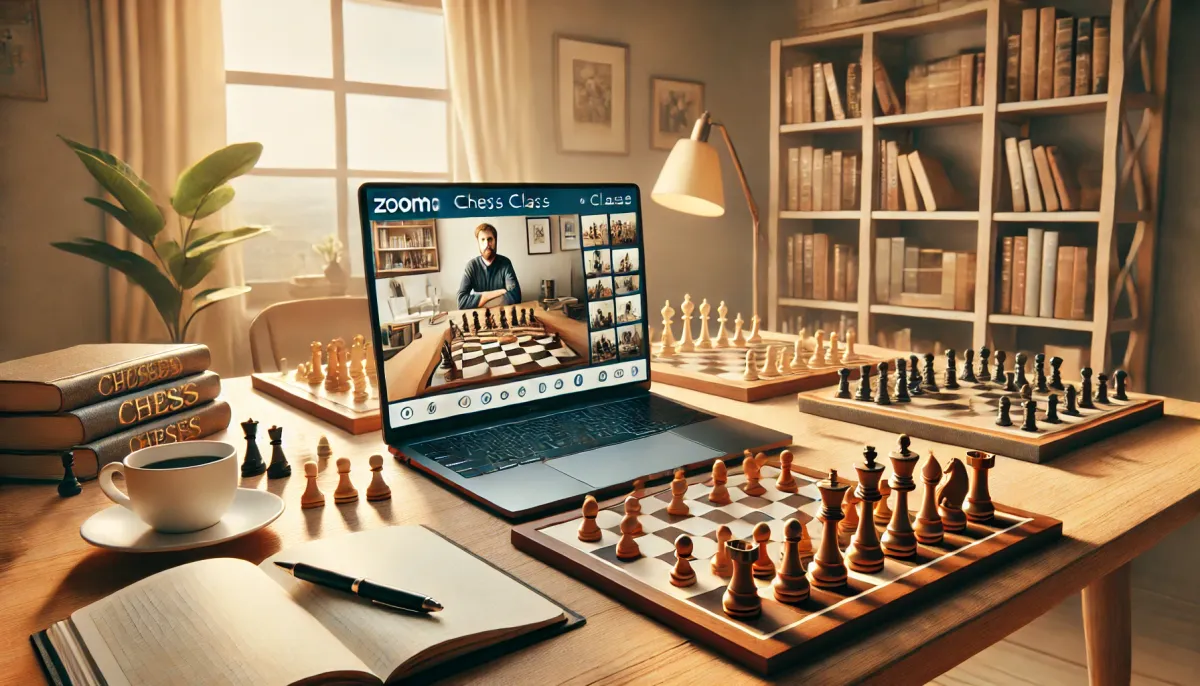Mastering Chess from the Comfort of Home: Rules for a Successful Zoom Chess Class

Learning chess online offers a unique and interactive way to hone your skills, whether you're a complete beginner or just looking to improve. To maximize the benefits of your virtual lessons, it's crucial to follow some best practices.
Here are detailed guidelines and examples to help you navigate your Zoom chess classes effectively.
Timeliness is Key
Arriving a few minutes early to your Zoom class ensures that you're settled in and ready to begin without missing any important instructions.
Set Up Your Space
Creating a conducive learning environment is essential. Ensure you have a stable internet connection and a quiet space free from distractions. For example, set up your laptop in a quiet room and inform family members not to disturb you during class time.
Mute to Minimize Distractions
Keeping your microphone muted when you're not speaking helps reduce background noise, allowing everyone to focus.
For instance, if you're in a busy household, muting your mic ensures that sounds like conversations, cooking noises, or pets do not disrupt the class. This simple action contributes significantly to maintaining a professional and focused learning environment.
Use the ‘Raise Hand’ Feature
To maintain order and ensure everyone has a chance to participate, use the 'Raise Hand' feature or type your questions in the chat.
For example, if the instructor asks, "Can anyone explain why controlling the center is important in chess?" you can use the 'Raise Hand' feature to share your thoughts or ask for clarification. This practice ensures that discussions flow smoothly and everyone's questions are addressed in an organized manner.
Active Participation Encouraged
Engage actively in the class by answering questions, participating in exercises, and engaging in discussions. For instance, during a lesson on opening principles, you might be asked to suggest moves for white after 1.e4 e5.
Don't hesitate to share your ideas, even if you're unsure. Active participation not only helps reinforce your learning but also makes the class more dynamic and enjoyable for everyone.
Respect Your Classmates and Instructor
A respectful and courteous attitude is essential in any learning environment. For example, if a fellow student is explaining their thought process, listen attentively and avoid interrupting.
Similarly, use polite language and tone when interacting with the instructor and classmates. A respectful atmosphere fosters a positive and supportive learning environment, encouraging everyone to engage and contribute.
Minimize Distractions
During the class, focus solely on the lesson. Avoid using your phone or other devices unless they're related to the class.
For instance, if your phone rings during a critical explanation of checkmate patterns, it can break your concentration and disrupt the class. By minimizing distractions, you ensure that you're fully present and absorbing the material being taught.
Don’t Hesitate to Ask Questions
Chess is a complex game, and it's normal to encounter concepts that are challenging to understand.
For example, if you're struggling with understanding the concept of 'pawn structure,' don't hesitate to ask your instructor for a more detailed explanation or examples.
Questions are an essential part of the learning process, and the instructor is there to help you grasp these concepts fully.
Importance of Chat Feature
The chat feature in a Zoom chess class is essential for fostering clear communication and inclusive participation among students and instructors. It allows students to ask questions, share thoughts, and receive real-time feedback without interrupting the flow of the lesson.
This feature supports those who may feel uncomfortable speaking aloud and encourages active engagement. Additionally, it facilitates collaborative learning, provides a record of the session for review, and enables the sharing of valuable resources.
Overall, the chat function enhances the virtual learning experience by making the class more interactive and accessible to all participants.
Take Detailed Notes
Keeping a notebook handy to jot down key points, strategies, and tips shared during the class can be incredibly beneficial. For instance, if the instructor explains a common opening trap, write down the sequence of moves and the idea behind it.
This practice not only helps reinforce your understanding but also provides valuable material for review and practice later. You can also note down any personal insights or questions that arise during the lesson.
Practice Makes Perfect
Chess is a game that requires consistent practice. Take the strategies and concepts learned in class and apply them in your own games. For instance, if the lesson focused on endgames, practice these scenarios against a friend or a chess engine.
Download Zoom in Advance
If this is your first time joining a Zoom class, make sure to download and install the Zoom application beforehand. This will prevent any last-minute technical issues and ensure you can join the class smoothly. Visit the Zoom Download Center to get the latest version compatible with your device.
By adhering to these guidelines and examples, you'll be well-equipped to make the most of your Zoom chess classes. Remember, the journey to becoming a skilled chess player is both challenging and rewarding—embrace the process, stay curious, and keep practicing!\
We hope this post proves useful to you, whether you are a coach or a student learning chess online. As Anatoly Karpov once said, 'Chess is everything: art, science, and sport.'
Remember to respect your teacher, honour the sanctity of the class and the game, and keep learning!